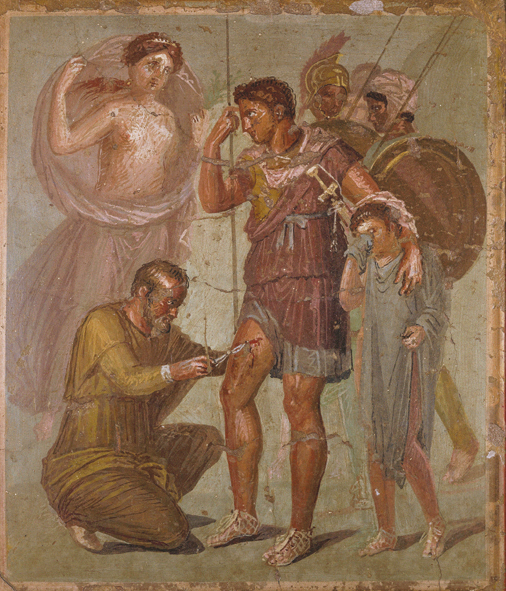Ancient Life: A Stitch in Time
Going under the knife in ancient Rome

As the first-century A.D. Roman encyclopedist Aulus Cornelius Celsus wrote in De Medicina, “A surgeon ought to be young, or, at any rate, not very old; his hand should be firm and steady, and never shake … His eyesight should be acute and clear, his mind intrepid, and so far subject to pity as to make him desirous of the recovery of his patient, but not so far as to suffer himself to be moved by his [patient’s] cries … as if the other’s screams made no impression on him.”
Thus the physician Iapyx attempts to remove an arrow from the thigh of the Trojan hero Aeneas (above), in this first-century A.D. fresco from Pompeii illustrating a scene from Virgil’s Aeneid. Virgil recounts that after the fall of Troy, Aeneas and his men sail into the Mediterranean, eventually settling in Italy, where Aeneas founds Rome. While fighting in Italy, Aeneas is wounded; when Iapyx fails to extract the arrow with “grasping tongs”, Aeneas’s mother, the goddess Venus (upper left), arrives with the healing herb dittany, which she has brought from Crete.
Celsus’s writings indicate that Roman doctors used ligatures to stem bleeding and developed plastic surgery procedures, such as removing stigmatizing brands from freed slaves. Although the ancient physicians knew nothing of bacterial infections, they generally boiled their surgical instruments before each use. They cleaned wounds with acetum, an acidic, vinegary substance that serves as a mild antiseptic—a procedure rediscovered in the 19th century by the British scientist Joseph Lister, who experimented with carbolic acid.
Already a library member? Log in here.
Institution user? Log in with your IP address.

